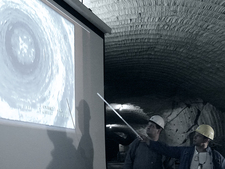Second exploratory drilling reaches emplacement chamber 7

![]() Two members of staff of Asse GmbH evaluate footage of bore hole inspection
Two members of staff of Asse GmbH evaluate footage of bore hole inspection
According to the Asse GmbH, the second exploratory drilling reached emplacement chamber 7 on the 750-m level on 7 June 2013, about five weeks after the start of drilling and after having drilled around 23 metres. Structures of strongly pressed salt powder were met. First evaluations of salt powder samples from the chamber have not shown any radiological exposure to radioactive substances in the salt powder. Comprehensive gas measuring programmes are currently being carried out.
Drilling reaches waste packages
The Asse-GmbH reported on 12 June that the drilling team had discovered a first waste package in the process of drilling another section. Measurements with the aid of magnetic field probes to detect metal preceded the drillings, in order to ensure that no drum would be destroyed that would possibly be near the bore hole. Furthermore, a shallow crown was used which cannot destroy the drums’ concrete shielding.
According to current information, this waste package is encased in concrete. It is located around 20 centimetres behind the chamber wall and the salt powder found there.
Drilling work is accompanied by comprehensive investigations
Drilling works started on 30 April 2013. The drilling initially penetrated the sealing construction and headed then to the chamber from the side.
The drilling works were accompanied by comprehensive investigations and the drilling was monitored by a camera on a regular basis. With the help of radar measurements the sealing construction and the camera access were investigated further.
Gas samples were measured to see if they contained explosive gas mixtures. Previous findings have shown that no explosive gas mixtures are present. Furthermore it was examined whether radioactive substances have entered the mine through cracks in the salt rock and have deposited in the surrounding rock. So far this could be ruled out.
Objective of the exploratory drillings
With the help of the exploratory drillings and, later on, the opening of two emplacement chambers and the test-wise recovery of waste it is to be found out whether it will be possible to retrieve all the waste. According to current knowledge, retrieval of the waste is the only option to close the repository for low-level and intermediate-level radioactive waste safely according to the standards of the Atomic Energy Act.

